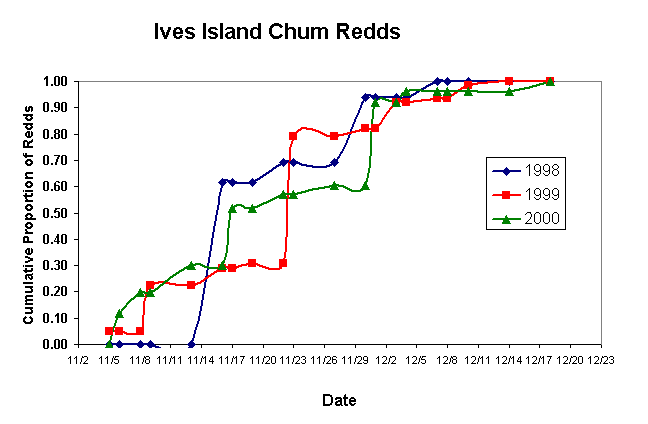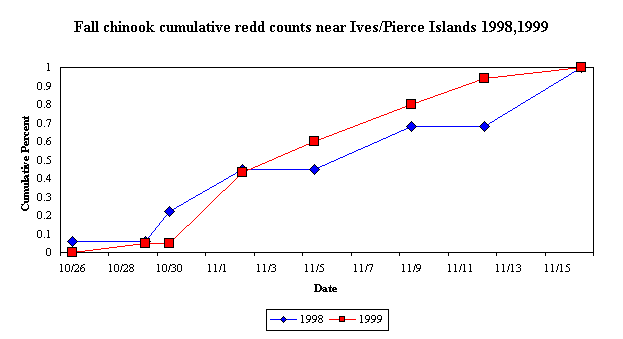
Ron Boyce, Chairperson, Salmon Managers
| TO: | Brigadier General Strock | COE-NPD |
| William Branch | COE - Water Management | |
| Cindy Henriksen | COE-RCC | |
| Doug Arndt | COE-P | |
| Col. Randall J. Butler | COE - Portland District | |
| Lieut. Col. W. E. Bulen, Jr. | COE - Walla Walla District | |
| J. William McDonald | USBR-Boise Regional Director | |
| Steven Wright | Acting BPA-Administrator | |
| Greg Delwiche | BPA-PG-5 | |
| FROM: |
 Ron Boyce, Chairperson, Salmon Managers |
|
| DATE: | October 29, 2001 | |
| SUBJECT: | Tailwater elevation at Bonneville Dam to protect natural spawning of chum and fall chinook salmon at the Ives / Pierce Island Complex and the I-205 seeps. | |
| SPECIFICATIONS: | Beginning November 5 and continuing until further notice, provide a minimum instantaneous tailrace elevation of 12 feet at Bonneville Dam under conditions where FCRPS operation is consistent with conditions of the Vernita Bar Agreement and NMFS' 2000 FCRPS Biological Opinion RPA. | |
JUSTIFICATION: The Ives / Pierce Islands Complex below Bonneville Dam represents a limited remaining natural spawning area for ESA listed Columbia River (CR) chum and Lower Columbia River chinook. The NMFS Biological Opinion establishes a chum minimum instantaneous spawning flow of 125 kcfs for the area beginning November 1 or when chum are present. The Biological Opinion does not establish spawning flows for Lower Columbia River chinook. Although mainstem flow and reservoir storage in the FCRPS are at historic low levels, we believe there is some opportunity to provide minimum flows for chum and chinook spawning without significantly affecting System Reliability or reducing water for other ESA listed fish as well as Hanford Reach fall chinook. USFWS' and ODFW's flow request for chum and chinook spawning this year is substantially less than what the Salmon Managers have requested in the past (Attachment 1) and represents an approach that better balances low reservoir storage between all ESA listed fish under the Biological Opinion than that provided by the proposed Federal Plan. The Federal Plan as discussed below, poses an unacceptable risk to CR chum.
The present flow (<100 kcfs) below Bonneville is not adequate to provide even limited spawning area for chum salmon at the Ives / Pierce Islands Complex and the I-205 seeps or provide access to both Hardy and Hamilton creeks. The provision of a minimum 12-foot tailwater elevation at Bonneville Dam will provide access to approximately 50% of mainstem spawning habitat for chum salmon and allow unrestricted access to Hardy and Hamilton creeks. Historic data (Figure 1) suggests that chum salmon will begin staging and spawning in the area around the first of November. In addition, LRB fall chinook are already present in the vicinity of the Ives / Pierce Island Complex, and based on data collected 1998-99 (Figure 2) have already begun to spawn in significant numbers with peak counts expected in early November. Increasing tailwater elevation to 12 feet will allow chinook access to preferred shallow-water habitat in the island area.
Exclusion of chum from shallow water spawning habitat in the mainstem (Ives Island Complex and I-205 seeps) and tributaries as would occur under the Federal Plan by not initiating spawning flows until November 19 would have grave consequences. This risk is not acceptable because there is some chance that adequate chum flows can be provided without significant impacts on other fish and power operations. Based on research collected to date, the island areas and tributaries are the only suitable spawning habitat for chum. Unlike chinook, chum cannot spawn in the high velocity large cobble substrate of the mainstem. Therefore, if spawn timing is similar to 1998, by not providing spawning flows until November 19 we could potentially lose production from over 60% of chum returning to the mainstem and tributaries this year. This poses an extraordinary risk to this population that number less than 1% of their historic abundance.
The potential impacts on Vernita Bar Agreement flows for Hanford Reach fall chinook spawning have been considered. The mid Columbia Hourly Coordinating Group has established a protection level of 55 kcfs that is supported by many parties of the Vernita Bar Agreement. Model studies by BPA has shown that flows of 60 kcfs throughout incubation can be assured in 100% of years and the Joint Fishery Parties of the agreement have indicated that a 60 kcfs protection level may be acceptable. However, even at a 60 kcfs protection level and expected lower Columbia base flows, it would not be possible to reverse load enough storage to provide the requested flows at Bonneville while maintaining daytime flows of 60 kcfs without the possibility of spill at Priest Rapids which violates the agreement.
However, the amount of water needed to pass through the mid Columbia projects while meeting the 12-foot gauge is dependent on lower Columbia base flows and precipitation over the course of the next three weeks. With high levels of rainfall and lower river flows, the mid-Columbia flow restrictions would not be limiting. For example, conditions in 1977 were extremely dry, but 1978 was very wet in the fall and if that occurred this year would allow meeting both objectives.
The Federal Action Agencies should explore ways to provide the requested Bonneville flows while complying with the Vernita Bar Agreement including an analysis of higher protection flows at Vernita Bar and use of limited USBR and IPC storage in the Snake River to help meet Bonneville spawning flows. The feasibility of compensation of Grant County for spill at Priest Rapids by BPA should also be explored.
The impacts of the request on System Reliability and water for other ESA listed fish must be evaluated in a quantitative and systematic way. ODFW's support of this operation is contingent on: maintaining acceptable levels of risk to Vernita Bar flows, URC refill for spring and summer flows, maintaining chum flows through emergence, and winter power reliability. Depending on weather patterns, there is a probability distribution of meeting all of these goals. The question is when and under what conditions can we start a chum flow operation while maintaining acceptable levels of risk of completing the chum operation and all other operations. There is clearly a risk of starting the chum operation and not being able to complete it because other operations have higher priority. If winter and early spring flows are inadequate to protect chum below Bonneville and meet other priority fish and power needs, ODFW and USFWS acknowledge that dewatering of chum redds may be necessary.
Brood stock collection (30 pair) from adult chum returning this year to the island area is planned for the Duncan Creek Chum Salmon Reintroduction Program conducted by Washington Department of Fish and Wildlife. However, the collection of brood stock does not preclude the need to provide minimum flows to maintain natural spawning of chum and chinook in the Ives / Pierce Island area and Hamilton and Hardy creeks. Although the hatchery program can play a valuable role in supplementing and averting risks to natural populations, the Duncan Creek program should not be considered an acceptable alternative to provision of adequate flows and habitat for natural production. The opportunity for enhancing natural spawning areas and production in the mainstem Columbia system is extremely limited and should be given high priority for protection and enhancement.
 Figure 1. Chum redd counts.
Figure 1. Chum redd counts.
 Figure 2. Fall chinook redd counts.
Figure 2. Fall chinook redd counts.
 MEMORANDUM
MEMORANDUM
| TO: |
Brian Brown, NMFS Therese Lamb, BPA Cindy Henricksen, COE Kim Fodrea, USBR |
| FROM: |
 Jim Nielsen, WDFW  Marv Yoshinaka, USFWS |
| DATE: | September 18, 2000 |
| RE: | Proposed Protection Measures for the Ives / Pierce Islands Spawning Area |
The Washington Department of Fish and Wildlife (WDFW), and the U.S. Fish and Wildlife Service (USFWS) have developed the attached proposal, identifying protection of spawning, incubation and emergence habitat based upon data collected in ongoing research at the Ives and Pierce islands sites. The purpose of this proposal is to begin discussions, based on the available information, of fall and winter hydrosystem operations to provide spawning, incubation, and emergence habitat protection for naturally spawning fall chinook and chum salmon at the Ives / Pierce Islands complex site. This proposal is based upon observations and findings of research conducted at the site over the past three years. Research is continuing which will further define and refine the operations needed to protect this natural spawning habitat in the future. Future protection requirements will be determined by the results of future data collection and analysis. The objective of this proposal is to provide Columbia River mainstem natural spawning habitat for tule fall chinook, bright fall chinook, and chum salmon. Spawning habitat in the mainstem Columbia River was nearly eliminated with the construction of the hydrosystem with the exception of the Hanford Reach and the limited area downstream from Bonneville Dam. In addition, Lower Columbia River chinook salmon (includes tule stock) and Columbia River chum salmon were listed as threatened under the Endangered Species Act in March 1999.
Our observations of present operations affecting the Ives / Pierce Islands sites and SSARR projected operations give us cause for significant concerns. We are concerned that the present and forecasted operations at Bonneville Dam will have detrimental effects on spawning adult fall chinook. Recent hourly flows at Bonneville Dam have fluctuated between 150 kcfs and 97 kcfs. The operating agencies and NMFS need to consider the adverse effects of higher September flows if they do not intend to maintain these flows through October. There is potential that listed Lower Columbia Tule Fall Chinook will enter and utilize the Ives / Pierce area at the higher flows and may be dewatered if flows decline in October as indicated in the SSARR forecast. In addition hourly flow fluctuations if not controlled, will be problematic for any spawners at the flows presently being projected.
In a related matter, the Columbia River Intertribal Fish Commission asks us to remind you that they have requested specific pool level operations in the lower Columbia during the tribal treaty fishery and are concerned with the lack of compliance with their requests.
We hope that the attached technical information and observations will assist the operating agencies in protecting the Ives / Pierce natural spawning area.
Ives / Pierce Islands Spawning, Incubation and Emergence Protection
Spawning surveys conducted during fall of 1998 and 1999 indicated that bright fall chinook begin staging in the area in early October (October 10). In addition, tule fall chinooks were observed building redds near the mouth of Hamilton Creek on September 29, 1999. Based on subsequent redd counts and spawned out carcass counts, these tules likely arrived in the area at least as early as September 15. Chum salmon begin staging in the area about November 1. Our observations thus far indicate that on the average, the minimum depth required for access to Hardy and Hamilton creeks is 125 kcfs. This flow should provide access to these areas over the range of stream configurations that have been observed thus far. The following proposal identifies time periods and flow magnitudes that would provide an adequate amount of habitat for staging and spawning by tule fall chinook, bright fall chinook and chum salmon at the Pierce / Ives Islands complex. The specifications outlined in this proposal are based on the results of three years of observations and data collection for staging and spawning chinook and chum salmon, as well as data collection and analysis for river flows and elevations at Bonneville Dam and throughout the Ives / Pierce Islands complex.
The WDFW and USFWS believe that the following specific operations and time periods provide needed protection for chinook and chum salmon spawning, incubation, and emergence in the Ives / Pierce Islands complex.